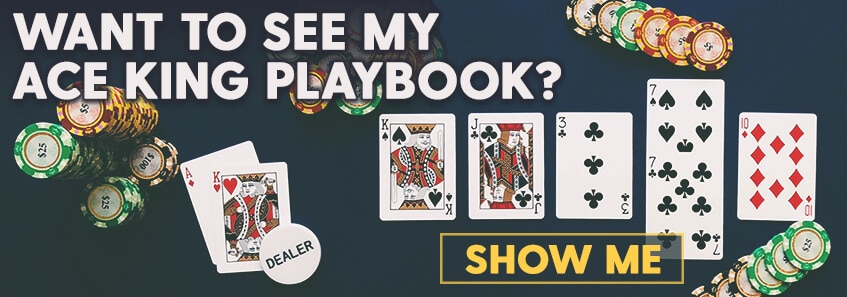Folding AK (Ace King) preflop is not something I typically advise doing. But, there are some correct spots to do so which can help you avoid spewing money on nitty players. In this video, we’ll break down a hand from $2/$5 and see if making a big fold preflop was actually a huge mistake.
Along with the hand, Ray actually sent in a write-up as well. This is what Ray said:
“I’ve been playing at this table for a little over an hour, and villain had been playing extremely tight the entire time. There had been a lot of limping and limp-calling preflop, and I don’t think there was a single 4-bet since I had sat down at the table. After two players limped in front of me, I raise, one relatively tight player calls behind me, villain then shoves all in over the top.
This move seems uncharacteristic for him in particular, especially with how the game had been playing prior to that point. I know a lot of people never fold AK suited preflop, but in that spot, I thought there was nothing that he would shove like that with aside from aces or kings. SO my question is do you ever fold AK preflop?”
Oddly enough, Ray’s question here, “Do you ever fold AK preflop? Can you ever get away from it preflop?” is actually not a very rare question. In the preparation of writing the book Optimizing Ace King I reached out to a bunch of people prior and asked “what’s one or two questions you have about AK?” Honestly, about 40% of the responses were all about this kind of thing:
“When should I get rid of AK preflop?”
“When can I get rid of it?”
“When can I fold top pair post-flop?”
“When can I fold it against a 3bet preflop?”
Notice that all of these questions revolve around mucking AK.
Now, let’s look at this situation mathematically to see if folding it actually makes sense and talk about when it does make sense, and when it’s probably something that we want to avoid doing altogether.
To solve this, we actually just need two things. One is my spreadsheet that analyzes situations where you’re calling shoves and also spots where you’re shoving yourself. In this spot, we’re just going to use the sheet all about calling shoves. Then we also need any sort of equity calculator. I’m going to use Equilab for this. I’m just going to leave the link in the description box of the video showing how to get this and also how to use it.
We just have this spot where we are calling $265 to win the current pot, which is $372 effective. Yes, he’s shoving for $550, but the effective pot that we can win right now is $372. We only need 3 numbers when we’re calling a preflop shove:
1. How big the pot is BEFORE we call
2. How much we have to call
3. Our equity when we do call
The equity we can figure out using a program like Equilab. So we already have our AKs in here. Let’s just take an absolutely worst case scenario and say that our opponent has exactly aces and kings, which is kind of what Ray thought that he might have, evaluate it, and notice that we have 23% equity.
We just go into the spreadsheet, put that in, and we see exactly what this is worth. So when we are against exactly KK+ here, we’d be losing $118 on the call. Well, pretty easy to see that that’s not going to be a profitable thing for us to do. So to the question of can we ever fold AK preflop? Well, in this situation, when we think we’re against the absolute worst of it and we’re very, very certain on that, yes, you can get away from it. It is mathematically correct to fold your AK preflop in this scenario. But I’m really a person who’s satisfied just doing a single exploration, so let’s explore something else here as well.
In this situation, let’s say the villain was shoving a slightly different range of hands. So using the same, exact tools, we have the exact, same numbers here in terms of how big the pot is, how much we have to call. But our equity is going to change when we think our opponent is shoving a different range of hands.
Assume for a moment that we thought villain was shoving QQ+/AK. And just go in, evaluate that, notice we have 42% equity, a number you should have memorized. Perfect. You notice that it is a break-even call.

Now, this little kind of spreadsheet thing happening in here, this little graph is showing some other EV scenarios, so this is if we had a 5% reduction in equity. And that’s not a pure 5%. That’s this going from 42 to 37, negative 10 on the equity, plus 5, plus 10. So this kind of gives you a rough idea of what similar things look like if it bends slightly more favorable, what you can expect if it bends slightly less favorable, what you can expect as well.
You notice that if you think villain is shoving in that range, then obviously this is pretty much just totally break even. And then if you’re like, “Well, I think this is kind of better case scenario for him,” I think more likely it’s going to be more KK+ for this individual, them, yeah, it kind of bends you more towards just getting out of this spot.
One thing I will say when you have someone who’s playing very, very tight – and we go back and kind of analyze this hand – I would say, “Wait a second. Is this dude really going to shove for the full stack with aces or kings? Or is he more likely to go to a hundred with aces or kings and then maybe shove things like jacks, queens, AK, things that he’s a little more uncomfortable with?”
Some players will, not all players, but it’s definitely something that you want to be aware of, at least question both in real time and when you’re exploring the hand-off table.
If we go back and we analyze this slightly differently, let’s just say that he shoves TT because he’s uncomfortable, JJ because he’s uncomfortable, QQ because he’s uncomfortable, and then some combos of aces and kings. So we do a suit selection, select those two hands, go in here, and let’s just say anything with a diamond in it, so that just selects half of them. Let’s throw in full AK, and let’s just leave it at that.
You notice that when we evaluate that, now all of a sudden we have 45% equity. Let’s see what that does to the total equation. Perfect. And you notice that, very slowly, that starts creeping more and more positive. So, again, we analyze something where we thought that someone’s bet size indicated a little less strength, a little more marginal stuff in terms of what they’re going to be comfortable or not comfortable with, and then analyze the math accordingly.
Again, when you’re in real time, you just have to say, “Okay, what range do I really think this dude is shoving with here? And then based upon that, based upon the very simple math, can I call this?”
Now, of course, in real time, you’re not going to be able to pull out Equilab, you’re not going to be able to pull out a spreadsheet and start plugging numbers in, but the more you do this off table, the easier it becomes to make these estimations in real time. Estimate whether or not it’s going to be plus EV or negative EV and make decisions accordingly.
So the question of, do we ever fold AK preflop, is really just too broad. Of course, there are some situations where we can, like we’ve already explored, and some situations where we definitely should not, like we also explored, and we’ve explored a ton of other videos as well.
In this situation, Ray did decide to fold. I’m not saying if that’s right or wrong, but in this scenario, this is how you proof it and this is what you look for when you’re looking at these situations on and off table.
That’s going to wrap it up for this video. Ray, thank you so much for the hand. And just as a quick reminder, please make sure to top off preflop. Don’t start hands with roughly $300 at a $2/$5 game. I think you can do much better being deeper and also it makes the situation a little more interesting as well.

